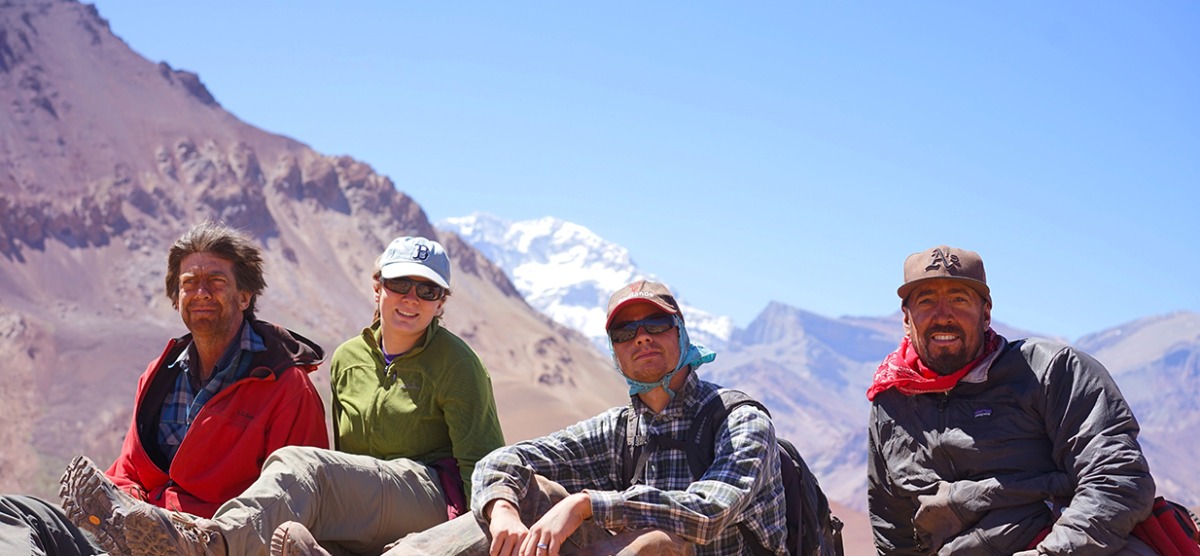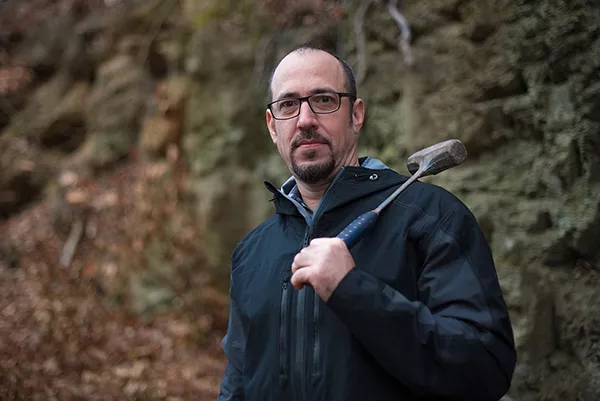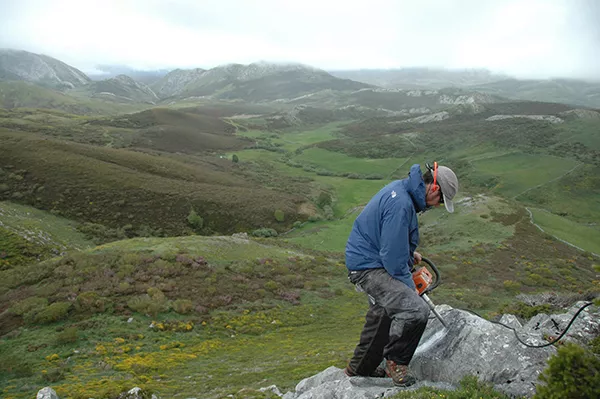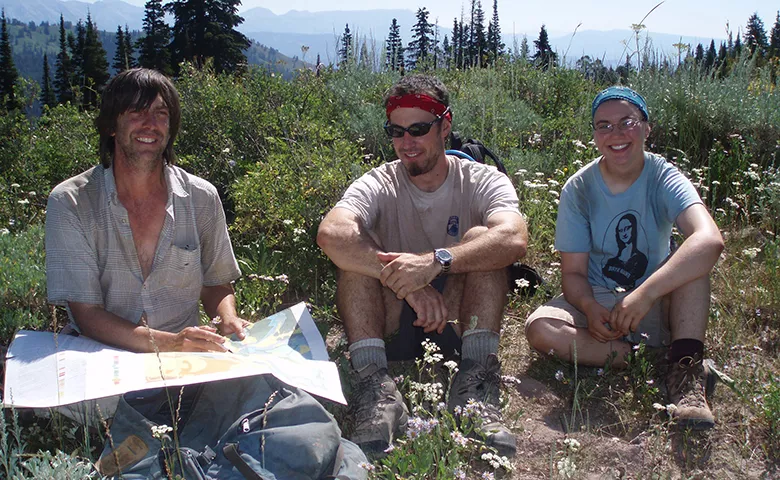
For Bryn Mawr's Arlo Weil, Geology Proved a Path to Adventure
Recent research has taken him to the Rocky Mountains and the Andes.
In presenting Geology Professor Arlo Weil their Outstanding Paper award for his research with W. Adolph Yonkee of Weber State University, the Geological Society of America said the pair’s findings, "should become the go-to reference on the evolution of the [Rocky Mountains] for years to come."
Now teaching at Bryn Mawr for more than 16 years, the honor is the latest milestone in an academic career that almost didn’t happen.
“I attended the University of Oregon intending to major in graphic arts,” recalled Weil in his office recently. “I enjoyed the art but so much of the business side of things involved creating this persona and that’s just not for me.”
Unsure of his future, Weil followed another interest and enrolled in an astrophysics class during his junior year even though he’d never thought of his interest in astronomy as any sort of basis for a career.
That class was life-changing in two ways—it was the first time Weil met his now wife of 21 years, Sarah, and it got him looking more closely at a career in science.
“I enjoyed the class but then we started talking about careers. The discipline at the time was mostly telescope-based and observational-based and you’re sitting at a computer just processing data the entire time,” he recalled.
An avid rock climber, a mountain biker, and a lover of outdoor activities, Weil knew that a life behind a desk was not going to cut it for him.
“I was still considering physics, and I had to take an allied science so I took an honors intro to geology course. By the tenth class, I was like, ‘This is what I want to do.’”
A field camp course led to a U.S. Geological Survey internship in Alaska, where Weil spent five months after graduation measuring river discharges for flood analysis and water chemistry.
“It was incredible. I got to see so much of the state. I was flying in on bush planes, landing in on point bars in the middle of rivers in the middle of nowhere. I was driving the Hall Road, which is a 400 plus mile dirt road that runs parallel to the pipeline up to the Arctic Ocean.”
While geology provided Weil an outlet for his love of both science and the outdoors, the idea of a career in the academy rekindled his fears of life at a desk.
“I wanted to continue the outdoor life for a while so I went to Aspen and worked as a cook and was sort of a ski bum for about a year.”
A move to Portland with Sarah followed, where Weil worked as a chef at one of the city’s better restaurants.
“The cooking thing was getting serious enough that I had to make a decision. I figured I was young enough that if I went back to school and failed, I could still be a chef.”
Weil was interested in tectonics and was admitted to the University of Michigan, where he studied with Rob Van der Voo, a leading expert in the field of tectonics who used paleomagnetism to study the ancient earth’s magnetic field as it is recorded in rocks.
“You can use that as a marker for lots of different analyses; he used it mainly for paleogeographic reconstruction. What did super continents look like? Where was North America 500 million years ago? Were continents different shapes, where they different sizes? What did they world look like, in map form, through time?”
It was at this time that Weil started to home in on the topics that would become the focus of much of his research: supercontinents and curved orogenic belts (mountain ranges).
Weil’s first paper with Van der Voo, which proposed a new construction for the Rodinia supercontinent, has now been cited over 400 times. His dissertation focused on the Cantabria-Asturias Arc, a curved orogenic belt in northern Spain that was formed during the amalgamation of the Pangea superconitnent.
Van der Voo remembers Weil’s trip to Spain coming on the heels of failed sample collection in North West Africa.
“The expedition was based on good scientific rationale but had not counted on the strong military presence there, nor on the local guerrillas,” recalled Van der Voo. “So, Arlo came back empty-handed. This in turn caused Arlo to shift his collecting to Spain, and what a lucky break that was, as one can see in his publication list.”
At the time of Weil’s dissertation, there was no shortage of hypotheses of how the Cantabria-Asturias arc evolved, with most models arguing that the shape of the mountain range formed curved.
Going against convention, Weil argued that a secondary event had caused the bending.
Many of the geologists studying the region disagreed, but one—Gabriel Guttiérez Alonso—thought Weil was on to something. Together the two would establish the findings, which are now widely accepted.
“I’ve been very lucky in that I’ve been able to ask interesting questions, and in looking for answers I’ve managed to have an impact on the broader community,” said Weil.
Weil’s latest research, done in collaboration with Adolf Yonkee, has taken the pair to the Rocky Mountains and the Andes. After spending nearly 13 years studying the Rockies, which have completed their tectonic evolution, the two are now testing some of their hypotheses about its evolution in the Andes, an active range where subduction is still occurring.
“You can ask different questions in an ancient system and an active system, and vice versa,” explained Weil. “We’re looking to see analogs between how the Rockies formed and how the Andes are forming.”
Over the years, Weil has mentored a number of students and brought them along to participate in field work. Most recently, he’s brought two students each summer to the Rocky Mountains. He’s brought students to the Andes and to Spain.
“I still remember what it was like when I was in college and trying to figure out what was going to make me happy,” said Weil. “When I see potential in a student, I try to give them an experience that will show them that they can succeed at academic work and that also gives them a chance to find out if it’s what they really want to do.”
“Working with Arlo over the past decade (and then some),” Yonkee said, “I have appreciated his dedication to students, his high energy, and his commitment to improving our understanding of mountain building. Not only have we collected one of the most extensive and informative data sets on curved mountain belts on Earth, from the Rockies to the Andes, but most important, we have had the opportunity to work with outstanding students who will be the next leaders in geosciences.”
Published on: 01/30/2018


